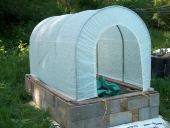





Some places need to be wild




Sometimes the answer is nothing





Let the land inspire you!





List of Bryant RedHawk's Epic Soil Series Threads We love visitors, that's why we live in a secluded cabin deep in the woods. "Buzzard's Roost (Asnikiye Heca) Farm." Promoting permaculture to save our planet.
 2
2




I make a Maple Syrup instructional movie! Check it out HERE
SKIP books, get 'em while they're hot!!! Skills to Inherit Property
See me in a movie building a massive wood staircase:Low Tech Lab Movie
















List of Bryant RedHawk's Epic Soil Series Threads We love visitors, that's why we live in a secluded cabin deep in the woods. "Buzzard's Roost (Asnikiye Heca) Farm." Promoting permaculture to save our planet.
 1
1




 1
1




I make a Maple Syrup instructional movie! Check it out HERE
SKIP books, get 'em while they're hot!!! Skills to Inherit Property
See me in a movie building a massive wood staircase:Low Tech Lab Movie




 1
1




Let the land inspire you!














Some places need to be wild
 3
3




Permaculture...picking the lock back to Eden since 1978.
Pics of my Forest Garden
 3
3




 3
3




Let the land inspire you!
 2
2




Let the land inspire you!
























Eric Hanson wrote:Thank you everyone for so many great ideas,
Regarding the logs as borders: All of my beds had log borders, but they are approaching a decade old and are starting to show their wear and tear. In two of my beds I actually broke up the remainder of the logs that were still left and dug them into the bed as a sort of hugel-light technique. My remaining beds likely have a few more years in them, but they too will decay away at some point. I don't want to go and chop down perfectly good hardwood trees to use them for garden beds so I was wondering what other options were available for 2x lumber. Everyone here has given me some great ideas.
Redhawk, I have heard of the borax-as-preservative before, but always in the context that it was water soluble and therefore transferred out of the wood (where you do want it) and into the soil (where you don't want it). Is there any truth to this? As a solution to this I have heard of people using the borax and then covering with either paint or tar like driveway sealant. I am interested on yours or anyone's thoughts on this.
Again, thanks in advance,
Eric
List of Bryant RedHawk's Epic Soil Series Threads We love visitors, that's why we live in a secluded cabin deep in the woods. "Buzzard's Roost (Asnikiye Heca) Farm." Promoting permaculture to save our planet.
 2
2









Moderator, Treatment Free Beekeepers group on Facebook.
https://www.facebook.com/groups/treatmentfreebeekeepers/
















Walt Chase wrote:Another suggestion would to use repurposed metal roofing. Use it in place of the wood and use rebar to hold it upright.
Mark Deichmann wrote:Masonry solutions are good...
I find in most areas there is always stone or other materials available for free or low cost and you will know best yourself what you can get.
Pecan Media: food forestry and forest garden ebooks
Now available: The Native Persimmon (centennial edition)




Joe Black wrote:We just finished building our kitchen garden and decided to build raised beds using cheap local pine timber (pallet boards) treated with shou sugi ban. It was our first attempt at this so there was a good bit of trial and error. It also took a lot of time to treat the boards with the blow torch and then assemble them, but I think it's worked out nicely and once I got into it, the shou sugi ban process becomes very meditative and creates beautiful patterns as you burn the wood. In the past we have built raised beds with no sides and they worked perfectly but the owner of the property shares the view of the kitchen garden with us and we didn't want to give the wrong impression of permaculture


|
God is a comedian playing for an audience that is afraid to laugh - Voltair. tiny ad:
The new kickstarter is now live!
https://www.kickstarter.com/projects/paulwheaton/garden-cards
|





